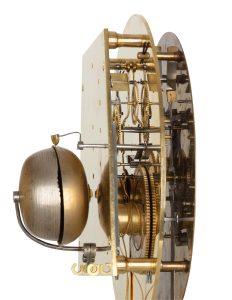Vienna, around 1810
- signed
- "Rauschmann in Wien"
- Clockmaker
- Josef Rauschmann
- Vienna/Budapest, 1812 master, †1845, clockmaker to the court of archduke Joseph, Palatin of Hungary
- Case
- polished cherry wood veneer, ebonized fruitwood inlays
- Dial
- silver-plated dial, jumping seconds
- Movement
- Graham escapement, seconds pendulum, two weights (positioned behind the pendulum), Viennese grande sonnerie on two bells with one hammer on a moving shaft - driven by just one weight, repeater, duration of eight days
- Height
- 56 in
Josef Rauschmann is among the most important Austro-Hungarian clockmakers of the 19th century. He earned the title of master craftsman in 1812 and was active in Ofen (part of Budapest) and Vienna. As a court clockmaker of Archduke Joseph, Palatine (governor) of Hungary, Rauschmann was commissioned with the most prestigious orders, such as a timepiece for the archducal residence in All-Csuth. Moreover, Rauschmann was among the ranks of master clockmakers awarded the honor of supplying observatories (e.g. the observatory in Buda). In 1813, an astronomical year-going clock was presented in the Hungarian National Museum and was described by his contemporaries as the highlight of the exhibition. Josef Rauschmann is one of the few clockmakers mentioned by name in Stephan Edler von Keeß’s report on Viennese clockmaking (1823), who describes him as a skilled master.
This museum-worthy regulator (“Laterndluhr”) by Josef Rauschmann impresses with its elegant clock case with a cherrywood veneer and ebonized fruitwood inlays. Typical for this early stage of Viennese regulators are the cases, which have not yet been developed into a classic type – so there is still a certain range of varieties such as, in this case, the semicircular end of the base, the movement case enclosing the dial (as opposed to later made of glass) and the crowning with an extension behind the gable. However, the piece, with a Graham escapement and seconds pendulum, already possessed the quality for which Viennese regulators were to become world-famous: its outstanding precision for the time. The small seconds display in the upper half of the silver-plated dial – a so-called jumping seconds mechanism – is directly coupled with the pendulum, which needs one second for each swing. The drive for the Viennese grande sonnerie with just one weight demonstrates special technical workmanship. Normally, the Viennese grande sonnerie requires a drive for the hour striking mechanism and another for the quarter hour. Josef Rauschmann, however, used a hammer with a shifting drive shaft. One and the same hammer, therefore, first strikes the bell for the quarter hour and is then immediately moved to the bell for the hour strike.
This superb Viennese regulator is a wonderful and rare example of the early phase of this genre of wall clock – a category of timepiece for which Viennese master clockmakers achieved worldwide acclaim.


